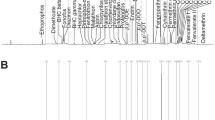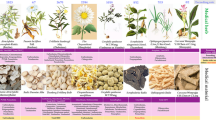Abstract
In order to reduce health risks from residual pesticides in herbal drug products, the residue information of pesticides should be acquired. Therefore, 38 commodities (229 herbal crude drug materials) were analyzed for 44 different pesticides. Among the 229 samples (36 types of herbal crude drugs), seven imported and two domestic drug materials were contaminated with eight pesticides (0.034–0.579 mg/kg) such as BHC, procymidone, endosulfan, etc. Among the eight detected pesticides, four were fungicides, which were found in underground crude drug materials such as rhizoma or radix.
Similar content being viewed by others
References
APVMA (2004) Does the use of endosulfan interest you? Information sheet, Australian pesticides and veterinary medicines authority, Canberra, Australia, Available from: http://www.apvma.gov.au/chemrev/endosulfan_information_sheet.pdf. Assessed 20 January 2007
BCPC (2002) Pesticide manual, 12th edn. British Crop Protection Council Publications, Hampshire, UK
Carper J (1991) The food pharmacy. Billing, Worcester, UK, p 207
Consumers Korea (2004) Usage of pesticides and regulations in Korea, research project report. The Office for Government Policy Coordination, Seoul, Korea
CSL (2006) Mode of action list, Fungicide resistance, Central Science Laboratory, York, UK, Available from: http://www.frag.csl.gov.uk/frac_table.cfm. Assessed 15 February 2007
EXTOXNET (1996) USDA/extension service/national agricultural pesticide impact assessment program. Available from: http://www.extoxnet.orst.edu Accessed 14 January 2007
Gerald TF (2005) A pesticide’s toxic legacy. Commission for Environmental Cooperation, Available from: http://www.cec.org/trio/stories/index.cfm?ed=16&ID=178&varlan=english. Accessed 20 January 2007
Han LK, Xu BJ, Kimura Y, Zheng YN, Okuda H (2000) Platycodi radix affects lipid metabolism in mice with high fat diet-induced obesity, J Nutr 130:2760–2764
JMPR (2003) Pesticide residues in food report 2003. In: The joint meeting of the FAO panel of experts on pesticide residues in food and the environment and the WHO core assessment group on pesticide residues (September 15–24), Geneva, Switzerland, p 179
KFDA (2002) Residual pesticide analysis in foods. Separate volume, In: Korea food code. Seoul, South Korea, p 258–263
KFDA (2005) MRLs and the analysis methods for the residual pesticides in oriental crude drug material, Official amendment notice No. 2005–72, 06 December 2005. Korea Food and Drug Administration, Seoul, South Korea
LabFrontier Co (2004) Improvement of multi-residue analysis method for pesticide in food, research project report. Korea Food and Drug Administration, Seoul, South Korea, p 110
NFA (2001) Pesticide monitoring in Finland-2000, fruit, vegetables and cereals. National Food Agency of Finland, Helsingki, Finland, p 28
Oh CH (2006) Applicability of using GC-PDD (pulsed discharge detector) for multiresidual pesticides analysis. Food Sci Biotechnol 15:959–966
Parziale E (2000) Atractylodes. Available from: http://www.earthnotes.tripod.com/atractylodes.htm. Assessed 20 January 2007
Schee HA (2002) Report of pesticide residue monitoring results of the Netherlands for 2001. Food Inspection Service, Amsterdam, The Netherlands, p 15
Acknowledgments
This research was supported by Korea Food and Drug Administration, South Korea. The author thanks Dr. Yook, Chang-Soo who was a professor of Oriental Pharmacy Department, Kyoung Hee University, Seoul, South Korea for providing his high expertise for herbal crude drug sample discernment.
Author information
Authors and Affiliations
Corresponding author
Rights and permissions
About this article
Cite this article
Oh, CH. Multi Residual Pesticide Monitoring in Commercial Herbal Crude Drug Materials in South Korea. Bull Environ Contam Toxicol 78, 314–318 (2007). https://doi.org/10.1007/s00128-007-9176-9
Received:
Accepted:
Published:
Issue Date:
DOI: https://doi.org/10.1007/s00128-007-9176-9




